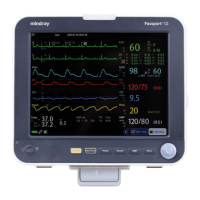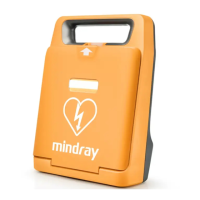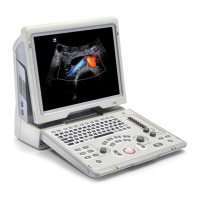5-11
7. Repeat the steps above to calibrate other IBP channels.
5.3.9 C.O. Test
Tools required:
Medsim300B patient simulator, or MPS450, or equivalent equipment
C.O. adapter box ( CI-3 module/cable, P/N: 3010-0289 for 300B; P/N: 5180500 for MPS450)
C.O. trunk cable (P/N: 0010-21-42716)
1. Connect the patient simulator to the C.O. connector on the monitor using a C.O. trunk cable and a C.O. adapter
box.
2. Set the blood temperature (BT) to 37 °C on the patient simulator and check that the temperature value displayed
on the monitor is within 37 ± 0.2 °C.
3. In the [C.O. Setup] menu on the monitor, set [Auto TI] to [Off], [Manual TI (°C)] to 2 °C, and [Comp. Const.] to
0.542. Select [C.O. Measure] to enter the C.O. measurement window.
4. Select [Start] in the C.O. measurement window to start C.O. measurement.
5. On the patient simulator, set the TEMP to 0 °C.
6. On the patient simulator, set C.O. to 5 L/min and wait for 3 to 10 seconds.
7. Verify that the C.O. value displayed on the monitor is 5 ± 0.25 L/min.
5.3.10 Nurse Call Reply Performance Test
Tool required:
Oscilloscope
To perform a nurse call reply performance test:
1. Connect the nurse call cable to the Multifunctional Connector of the monitor.
2. Enter [Demo] mode. Then select [Main Menu]
→
[Maintenance >>]
→
[User Maintenance >>]
→
enter the
required password
→
[Others >>].
3. In the [Others >>] menu, select [Nurse Call Setup >>] and then in the [Nurse Call Setup] menu, select all
optional [Alm Lev] and [Alm Cat.], and set [Contact Type] to [Normally Open].
4. In [Nurse Call Setup >>] menu, set [Signal Type] to [Pulse]. Force the monitor to generate an alarm and check
that the oscillograph displays positive pulses of 1s width when there is an alarm.
5. In [Nurse Call Setup >>] menu, set [Signal Type] to [Continuous]. Make the monitor to generate an alarm and
check that the oscillograph outputs continuous high level when there is an alarm.
